Toulouse defender Bafode Diakite has been one of the standout players in Ligue 2 this season. The 19-year-old Toulouse academy graduate broke into the first-team two seasons ago. He enjoyed even more senior football last term, though his season was disrupted by a couple of consecutive injuries – a bruised foot and a calf problem.
Following his side’s relegation from Ligue 1 to Ligue 2 – France’s equivalent to the EFL Championship – for the 2020/21 campaign, however, Diakité has firmly established himself as a first-team regular for Toulouse. He’s been sidelined through injury once again for Les Violets’ last three games but it’s reportedly not expected to be a long-term issue, so perhaps we may see him reclaim his spot in the starting XI for Patrice Garande’s side in the not-too-distant future.
His performances for the Occitanie club would certainly suggest that Diakité should slide back into the Toulouse squad once he returns to fitness, as he has played a significant role for his side this season and been effective in that role. In this tactical analysis piece in the form of a scout report, we will look at how Diakité has been used within Garande’s tactics this term and provide some tactical analysis of his key traits and attributes to determine why he’s been so effective in that role.
Diakité’s Positioning
The 19-year-old Toulouse man, who in the past, played alongside the likes of Rayan Aït Nouri, who recently joined EPL side Wolverhampton Wanderers on loan, at youth level for France, has played in positions all across the backline already at some point in his young career but this season, he has more often than not been playing as a left-centre-back in Toulouse’s three-at-the-back system – usually a 3-5-2.
As we will discuss at greater length later on in this tactical analysis piece, Diakité is comfortable with playing on the left side of defence despite being right-footed. He is proficient with his weaker foot and both on and off the ball, it doesn’t generally seem to be a major issue for him to be positioned on the opposite side of the pitch to his preferred foot.
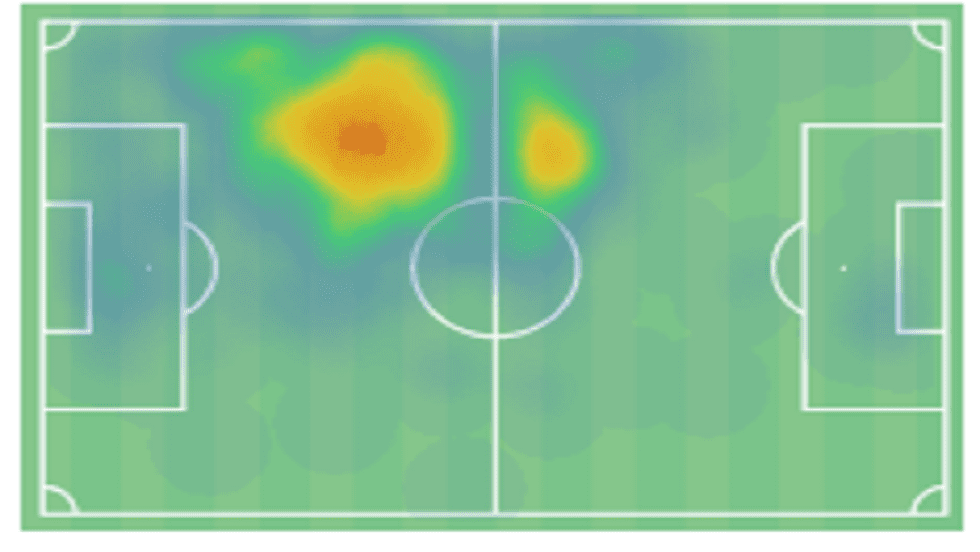
This image above shows us Diakité’s heat map for the 2020/21 campaign and this confirms that he has played as a left-sided defender.
We can see from this image that Diakité tends to spend a lot of time positioned quite wide despite being a centre-back and we will also discuss this at greater length later on in this tactical analysis piece but, essentially, Toulouse’s left wing-back tends to press fairly high and when attacks come down the left side of the pitch and he is beaten, Diakité shifts over and effectively becomes a left-back in a back-four with the rest of the defence shifting over along with him.
The heatmap also shows us a bit of colour just ahead of the half-way line inside of the opposition’s half of the pitch and Diakité’s tendency to step out of the backline and defend quite aggressively may explain this. He’s an aggressive defender who likes to stick tight to players even when they drop deep and as a result, sometimes finds himself defending higher up the pitch in this type of area, particularly when defending against counter-attacks and opposition goal-kicks, again, as we’ll elaborate on in later sections of this scout report.
Diakité’s aerial ability
The next element of Diakité’s game that we will touch on in this scout report is his aerial ability. The teenager is very physical, he’s well built and he’s good at using his physical traits to his advantage.
He stands at 185cm (6’1”) tall, which is a decent height but it isn’t exactly a ‘towering height,’ given he will be and has been beaten for size by some opposition centre forwards already this season, however, he has a good jumping reach and has shown himself to be able to compete in the air with players who have two or three inches of height on him. This makes him more than capable of competing in the air against the vast majority of forwards.
He is physical and aggressive when entering into aerial duels with opposition forwards and he’s comfortable with using his size and strength to get an advantage over players when contesting an aerial ball.
Furthermore, he is aggressive in seeking out aerial duels. He likes to roam from his position to contest aerial duels, which may indicate that his side recognises this area of his game as a notable positive and want to utilise it to the maximum.
As a result, Diakité finds himself between the lines contesting aerial duels fairly frequently but as Toulouse tend to use three centre-backs and two wing-backs, there is generally plenty of cover behind him for when he does this so a major gap doesn’t tend to open up in the defence and regardless, Diakité’s success rate in the air is exceptional in Ligue 2, so it may be fair to say the risk of this has been minimal.
Diakité has contested 8.11 aerial duels per 90 in France’s second-tier this term, which is fewer than just 14 other Ligue 2 players, two of whom are Toulouse players.
However, what may be more impressive is that he has a 71.43% success rate from those aerial duels – the second-highest aerial success percentage of any player in Ligue 2. This highlights how efficient the defender is in the air.
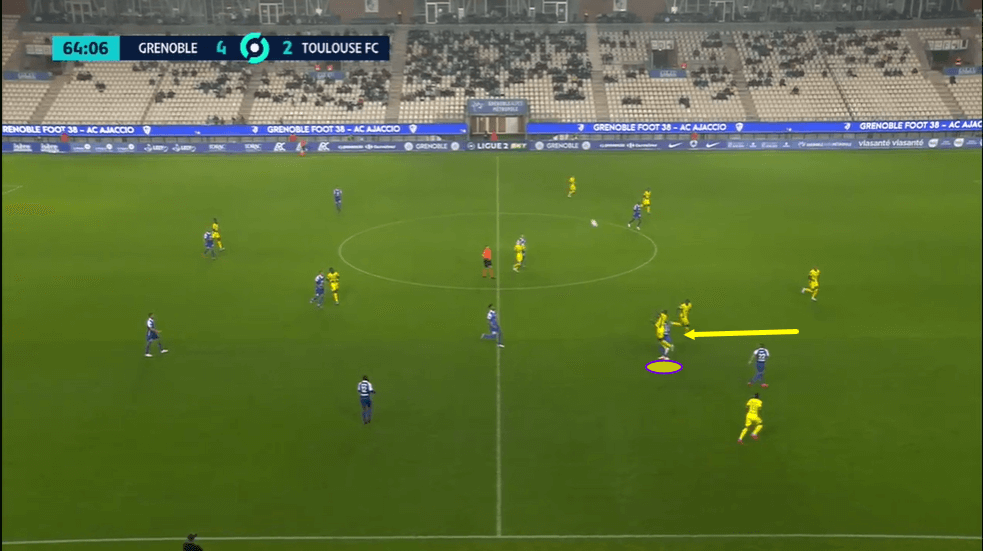
This image above shows us an example of what we’ve talked about concerning Diakité stepping out of his base position in the defensive line to engage an opposition player in an aerial duel.
As the opposition goalkeeper sends this goal-kick up the pitch, the centre forward, who is the intended target of this long-ball, drops deep and Diakité follows him.
We can see that this creates space in the backline that the central centre-back and the left wing-back are in the process of trying to cover, while another opposition attacker is trying to move into that space, however, we can also see that Diakité has leapt above the opposition player contesting the aerial duel with him and as a result, he doesn’t struggle to win the ball back for his side and alleviate the danger.
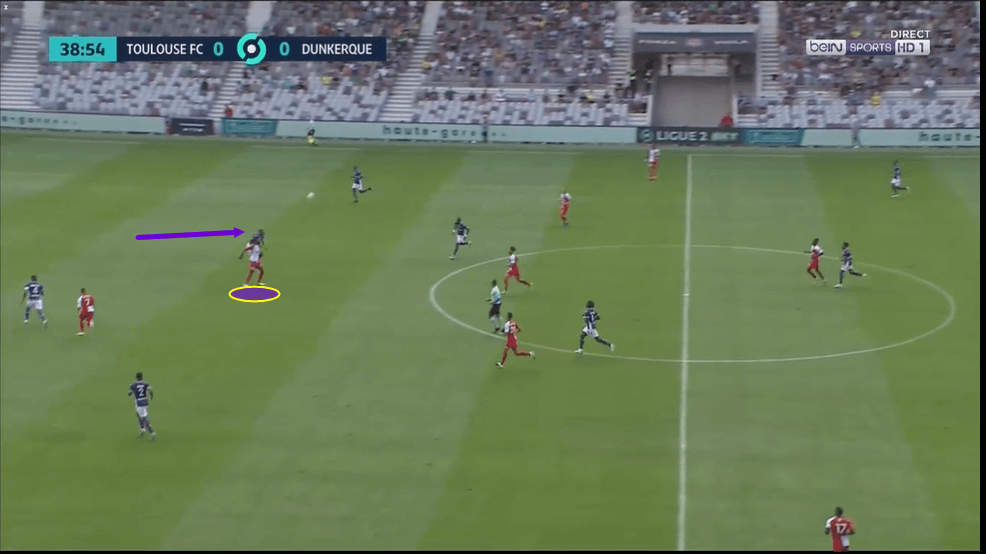
This next image shows us an example of a similar situation in a different game but on this occasion, the opposition player contesting the duel with Diakité is 191cm (6’3”) tall Malik Tchokounté of USL Dunkerque. So, knowing both players’ respective heights, we can use this image to back up our point on the Frenchman having a good jumping height.
Diakité had to contest several aerial duels with the target man throughout this particular game and he came out on top in a lot of them despite giving up a couple of inches of height, thanks to his jumping ability and his physicality which helped him to make up the difference in size between himself and the forward, thus nullifying one of the opposition’s biggest threats.
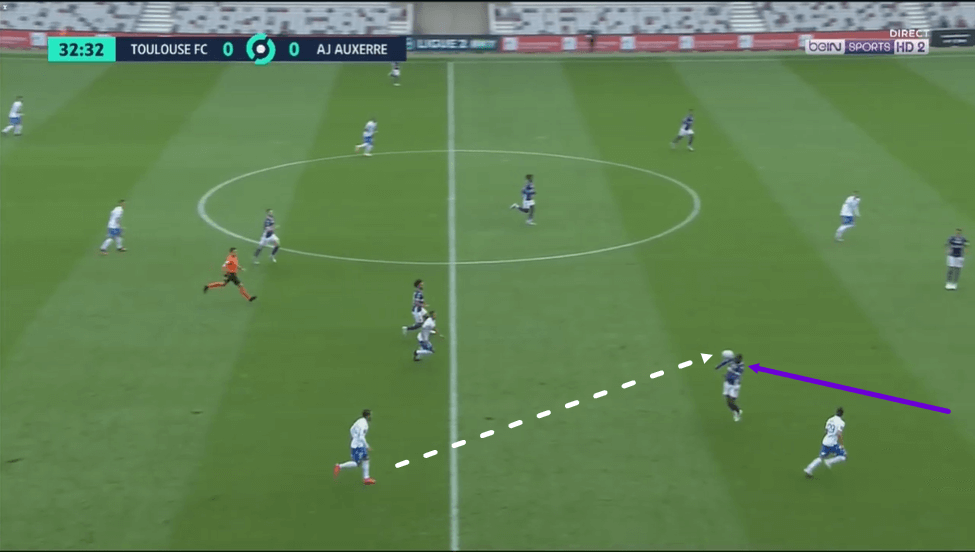
Lastly, for this section, Diakité has made 7.11 interceptions per 90 in Ligue 2 this season, which is impressively the eighth-highest number of interceptions any player has made in France’s second-tier this term and the second-highest number of interceptions that any Toulouse player has made in Ligue 2 this season. The image above shows us one of these interceptions and a common type of interception that Diakité makes – an aerial interception.
Again, his jumping and his aggressiveness are important for him to make these types of interceptions, as we can see, he is pressing just above the backline, while an opposition player is trying to run in behind him and another opposition player opts to try and play the ball through to him just over the pressing defender.
However, Diakité exhibits an impressive reading of the game and combines that mental attribute with the physical attribute of his jumping to cut out this attempted pass, shut down a potentially dangerous opposition attack and regain possession for his side – again, showing how important his aerial ability has proven to be for Toulouse.
Diakité’s aggressiveness
Diakité doesn’t have extremely high numbers in terms of defensive duels but they aren’t particularly low either. He has engaged in 7.78 defensive duels per 90 in Ligue 2 this term, which is the 12th-highest number for U21 players, while it places him seventh overall for Toulouse.
Les Violets have been very aggressive off the ball this season, which is evident by the fact that Garande’s side has got the lowest PPDA (7.5) of any Ligue 2 team for the 2020/21 campaign at present. This statistic indicates that they have been the most aggressive team in Ligue 2 in terms of their pressing and so, perhaps the fact they have pressed so aggressively from the front this term explains why as many as seven Toulouse players have engaged in more defensive duels than Diakité.
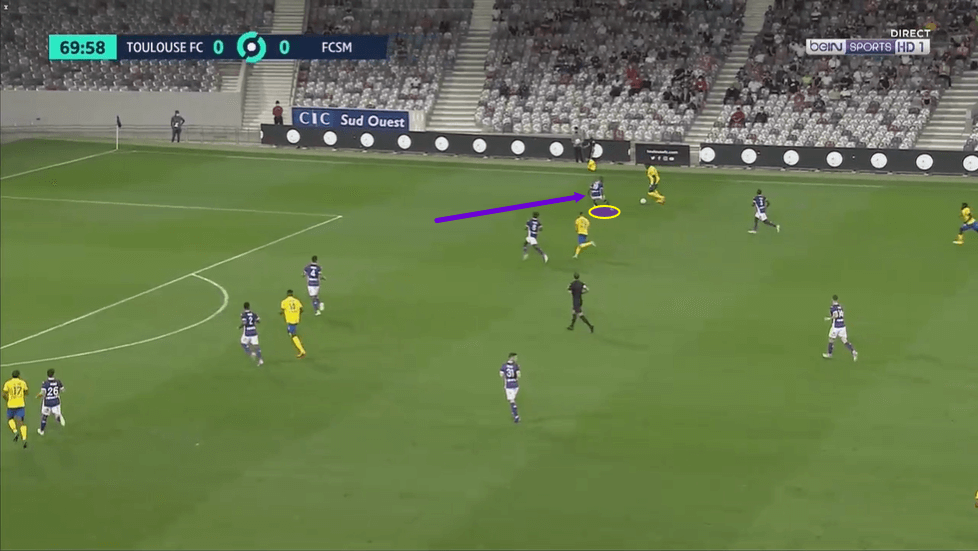
However, the 19-year-old still defends quite aggressively in his own right, as we’ve stated, and the image above shows us one example of Diakité’s aggressive style of defending in action.
Here, we can see that he has vacated his central position to press the opposition wide man out on the right-wing. As we mentioned in the positioning section, Diakité often finds himself in areas like this in a given game, as he often shifts out wide to cover the width during opposition attacks when the left wing-back is pressing higher or is just caught out of position. This image provides us with an example of that action taking place.
Diakité is very comfortable with playing this role and defending out wide. He has got the pace and the 1v1 defending skills to cope well as a wide centre-back and to cope well when defending in positions like this.
His 1v1 defending skills, in particular, are a highlight to his game. When standing up an opposition player like this 1v1, Diakité is very difficult to get past. He generally times his tackles well in these situations out wide where he can bide his time a bit, compared to when pressing even higher and being forced into a challenge a bit quicker. He is very good at closing the distance between himself and opposition players, sticking tight to them and giving them very little room to work with.
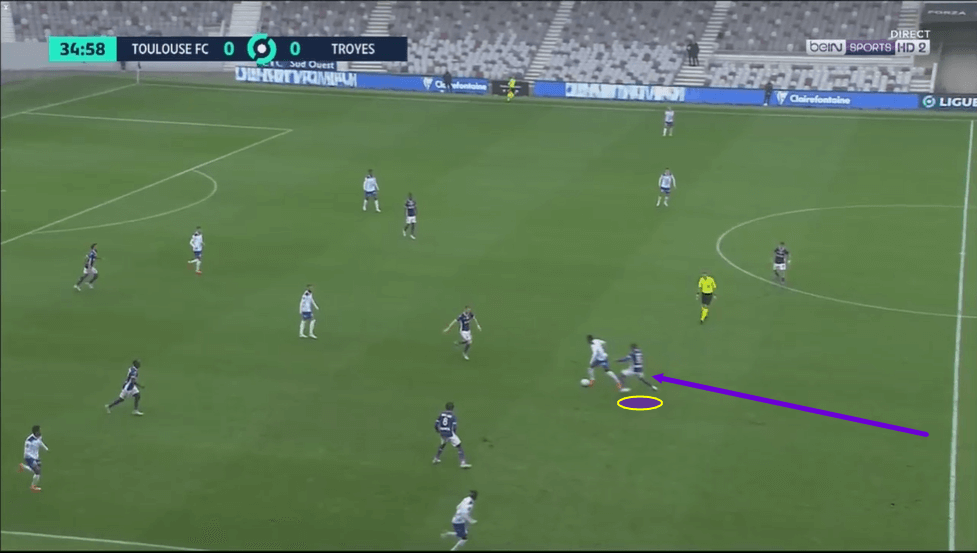
Diakité does also find himself in the type of situation we just alluded to where he is defending higher up the pitch and then is forced into committing to a challenge sooner, as the image above shows us.
Here, the centre-back followed the opposition striker as he dropped deep, which he is generally happy to do. However, he commits a challenge slightly too early, goes through the back of the player and gives away a free-kick in the opposition half.
He often gives away fouls when defending higher up the pitch in areas like this one in the opposition’s half as he has a slight tendency to rush into challenges when pressing more aggressively, compared to how patient he is when defending deeper and standing up opposition players running at him.
Diakité seems to be more effective defending in his half, be it in the wide areas or more central areas. Despite seemingly being comfortable with defending high up the pitch like this, there does also seem to be more negatives with his game when defending here, such as the issue of fouls.
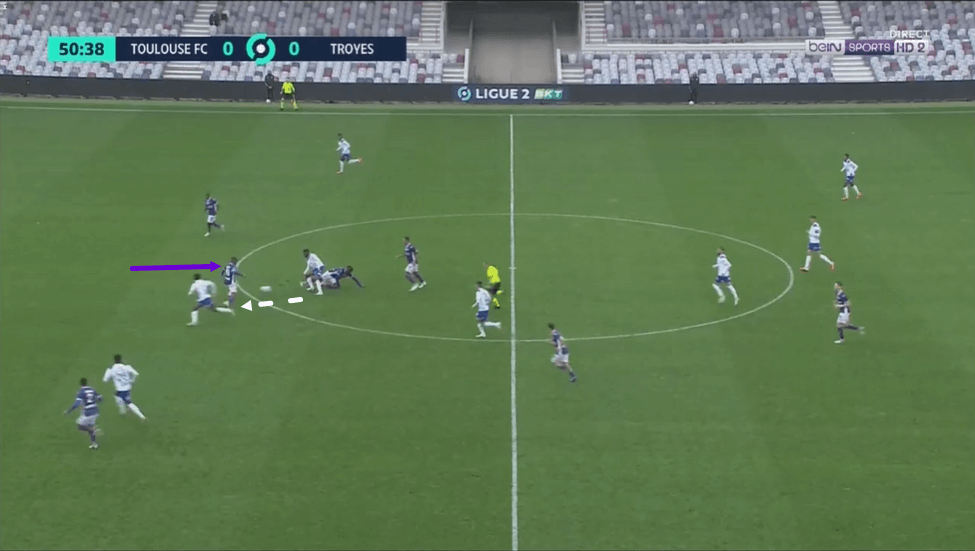
We’ve already looked at how Diakité steps out of the backline to contest aerial duels but he also steps out with the ball grounded and one purpose of this is he seems to like positioning himself high and defending aggressively when making interceptions.
He has made a lot of interceptions this season, as the numbers that we brought up previously might suggest and it seems that his aggressiveness and his pace play an important part in helping him to make many of those interceptions, as does his aerial ability that we discussed before.
Here, we can see the opposition trying to break through the centre of the pitch. Instead of tracking the runner moving in behind, Diakité gambles on himself to intercept the ball as it’s player from the ball-carrier and he manages to do just that.
During this passage of play, he exhibits some effective decision-making – albeit risky – effective pace, anticipation and clear confidence in himself and his ability to catch this danger before it becomes a big problem for his side, which he also managed to do. So, it’s clear that these attributes combine to help the defender make his interceptions.
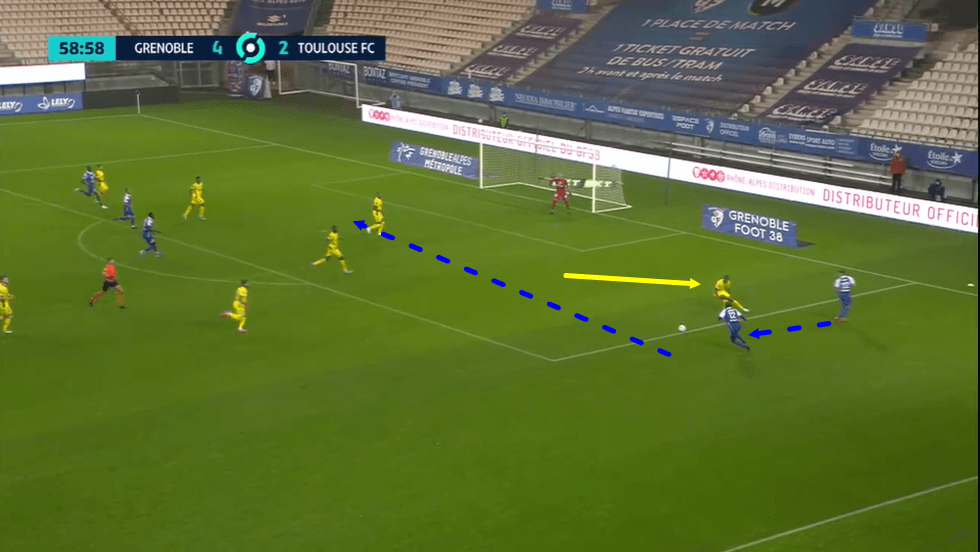
For the last part of this section, we will discuss one potential area of improvement for Diakité relating to his aggressiveness off the ball and that is in his agility, which has seemingly been exploited a couple of times this term, one of which we can see in the image above.
While Diakite is fast and mobile enough to cope well while defending out wide, he seems to struggle to turn at pace and when he commits to moving in one direction, a skilful turn from an agile dribbler or a pass from the player he’s charging down to a nearby player in more space who would force Diakité to have to try and turn around to close him down can effectively take him out of the game due to how slow he is to turn. So, the creation of 2v1 situations in space like this one in the image above has proven to be effective at getting around Diakité despite his top-notch 1v1 defending ability, his physicality and his solid aerial ability.
Diakité’s passing
In addition to being one of Ligue 2’s most aggressive sides off the ball this term, Toulouse has been one of their most possession-based sides too, as they’ve kept the ball for an average of 51.9% of the time this season. As Toulouse have spent a significant amount more time on the ball this season than they did last season, so too has Diakité and this has allowed him to demonstrate some impressive passing ability to a greater level than he did for Toulouse last season.
Firstly, the 19-year-old has been heavily involved in Toulouse’s general play on the ball, as he has played 48.47 passes per 90 this season – the 24th-highest number of passes that any Ligue 2 player has played this term and the second-highest number of passes that any Toulouse player has completed per game this season.
In addition to that, though, and what may be more impressive and telling about his strengths on the ball, is that Diakité has been one of Ligue 2’s best ball-progressors this term.
The centre-back has made 8.11 passes to the final third this season – the 28th-highest number of passes to the final third of any Ligue 2 player this season and the second-highest number of passes to the final third that have been played by any Toulouse player this season.
Additionally, he has made 10.92 progressive passes per 90 this season, which puts him in 19th place in France’s second-tier for that statistic.
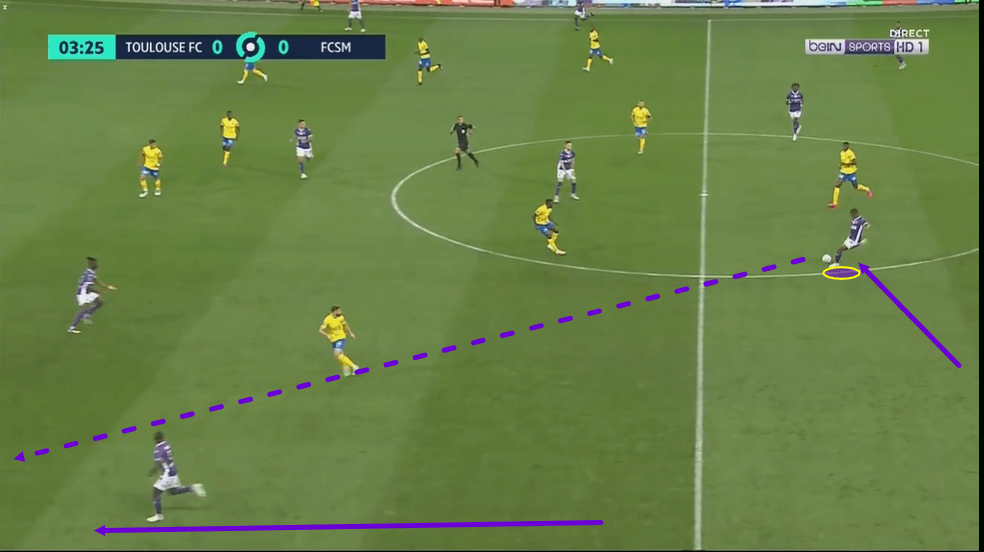
The image above provides us with an example of Diakité’s progressive passing ability in action and it’s clear, given that he has played a large number of passes like this one during the 2020/21 campaign, why his passing numbers are so impressive.
Firstly, this image shows us Diakité positioned in quite a central position, despite the fact he plays as a left centre-back in a back-three and that’s because just before this image is taken, the ball was on the right-wing and while it was there, this is the position that Diakité took up. As the ball was then played across, the 19-year-old was found in space and the left wing-back began to make an overlapping run which Diakité found via a long-ball played out to him via his right foot.
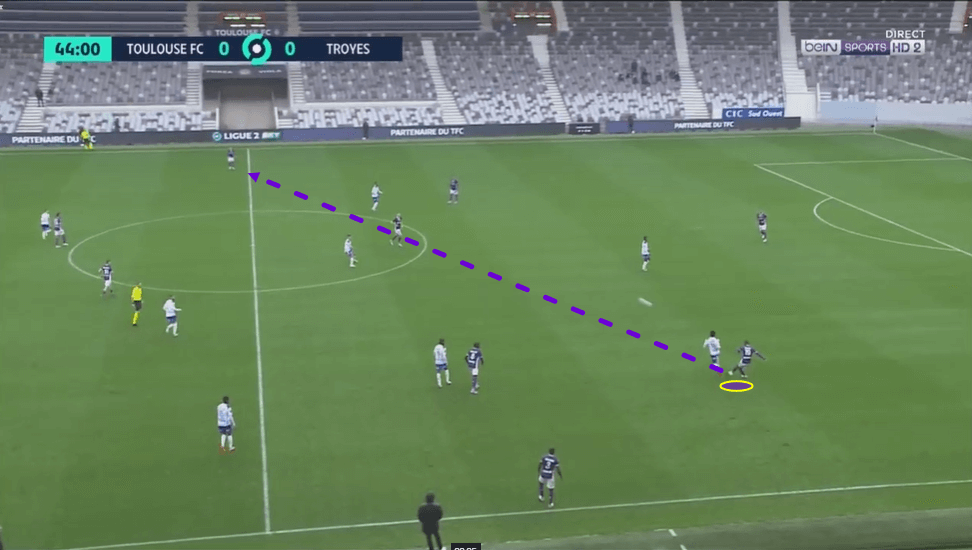
This pass to the overlapping left wing-back isn’t the only one that Diakité has looked for this term, however, as he’s also played plenty of crossfield balls to the right wing-back from his left centre-back position, which may tell us a lot about the player’s vision as well as his technical long-ball-playing ability.
Diakité likes to receive the ball deep, in space, from where he can spread it out to the wide areas. He also mixes it up by playing some long-balls through the centre to a target man or central runners in behind at times but he likes to look for the passes from the centre out to the wide-area or these types of crossfield balls.
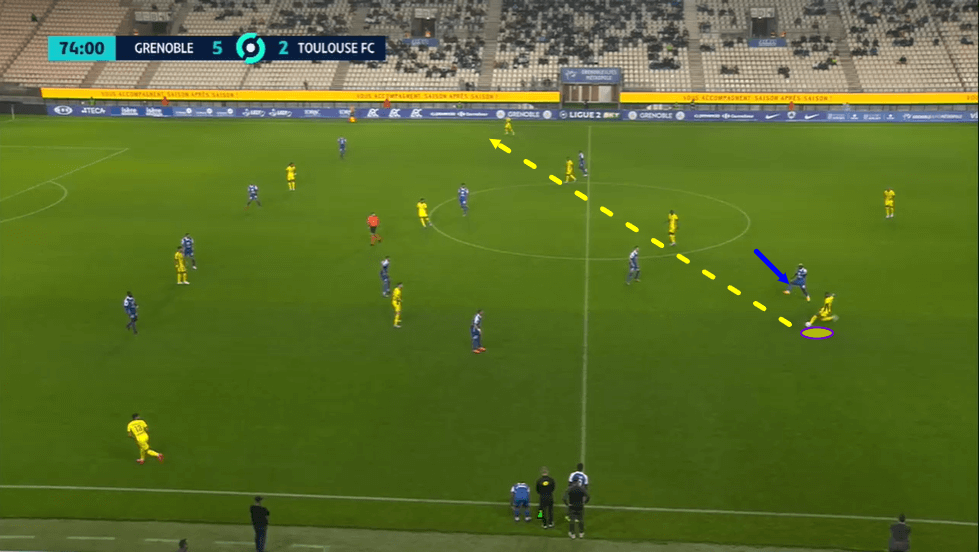
Additionally, while he is a right-footed defender playing on the left, Diakité is comfortable with using his left foot, which perhaps is one major reason why he is deployed on the left side of the pitch.
He tends to play passes with his stronger foot when and where possible but he is comfortable switching to his weaker foot if need be which is a valuable asset for his side.
In this image above, the opposition forward pressed Diakité on his right foot, essentially preventing him from shifting the ball onto that side but the centre-back was quick to come up with a solution for this as he simply lined the crossfield ball up on his left foot instead and managed to pull off the difficult pass effectively, demonstrating the valuable ability that he does possess with either foot.
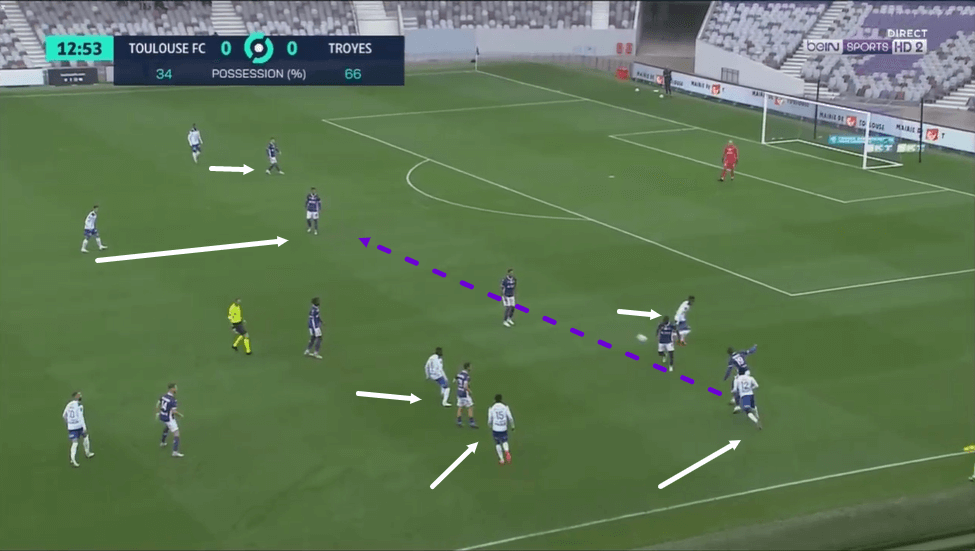
One negative to Diakité’s game on the ball is that he can, at times, be prone to error when placed under pressure. The teenager seems to panic quite a bit if surrounded by a large number of opposition players or if simply being pressed aggressively while his passing options are cut off.
We can see one example of the defender being pressed aggressively and surrounded by opposition players in the image above and instead of just clearing the ball upfield, he sends it across goal to a teammate who is also under pressure, except in a more central position and this player then had to receive the ball facing his own goal due to how the ball was played by Diakité so it may be fair to say the 19-year-old put him in quite a difficult position.
So, while Diakité thrives when given time and space on the ball to progress the play for his side, he is shaky under pressure and when making clearances and this can be and has been exploited this term.
Diakité’s recovery pace
The final element of the 19-year-old Toulouse man’s game that we’re going to analyse in this scout report is his recovery pace. To remain compact while pressing high up the pitch, Toulouse tends to play quite a high line and as a result, they leave space in behind for the opposition to potentially exploit on the counter.
Diakité’s pace helps with that. We’ve already seen how his quickness can help him to close down opposition players quickly both high up the pitch and out wide but it’s just as effective when defending against long-balls in behind on the counter.
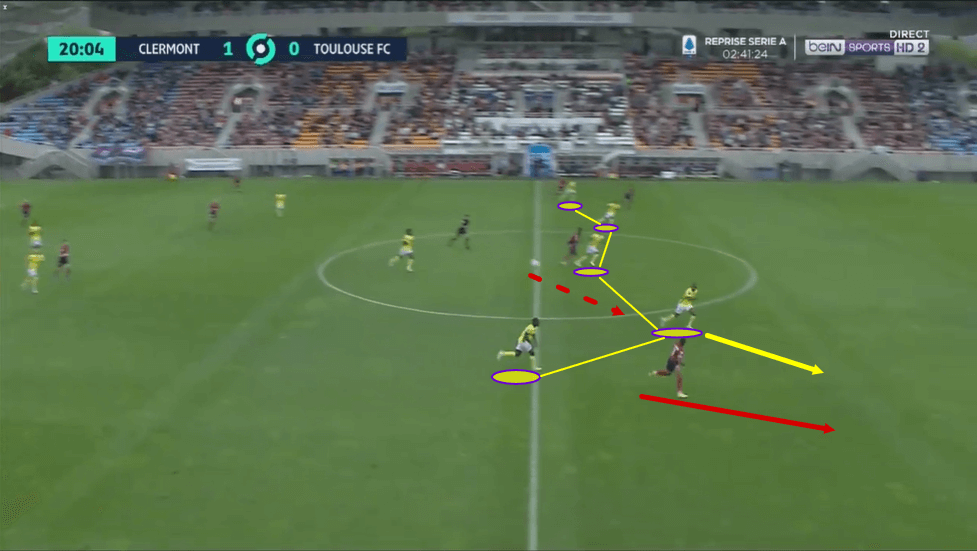
We can see one example of Diakité putting his impressive recovery pace to use in the image above. Here, we can see that the opposition has played a ball in behind for this runner to potentially exploit the space behind Toulouse’s backline on the counter-attack.
However, they’ve played this ball through on Diakité’s side and in this image, we can see that he is already tracking back and getting himself back between this attacker and his goal.
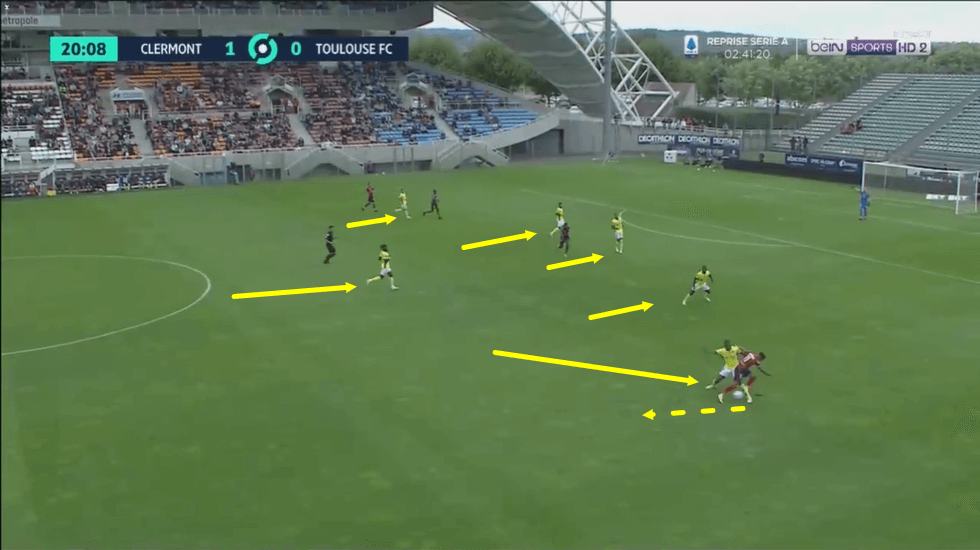
As the play moves on, we can see that Diakité did well to get himself back and in front of this player before they could start making strides straight through on goal on the counter.
As Diakité positioned himself between this player and the goal, he bought some time for his defensive partners to get back behind him, offering even more cover and all the while, he slows the game down and takes the momentum out of this counter-attacking opportunity.
We can see that the defender intelligently manages to create the type of 1v1 situation we discussed earlier in which he thieves and likes to defend in and as this dribbler eventually makes his move and attempts to take on Diakité, he is no match for the defender who quickly stops him in his tracks via some impressive technical defending ability and a well-executed stand tackle.
This wins possession back for Toulouse and allows Les Violets to spring a counter of their own. So, this shows us just how effective it is to have a player with Diakité’s recovery pace in the backline for a team that defends as high as Toulouse do.
Conclusion
To conclude this tactical analysis piece in the form of a scout report, it’s clear that Diakité has demonstrated quite a lot of positives to his game this season and is seemingly developing into a well-rounded modern centre-back.
His aerial quality and long-ball playing ability are excellent, while he also excels in 1v1 defensive situations and possesses good recovery speed.
He isn’t without his faults, the same as any young player, and he can improve on several areas, notably, how he deals with pressure on the ball, his agility and his defending in advanced areas of the pitch.
However, it’s easy to forget he’s still just 19-years-old when watching how dominant he has been on the pitch in France’s second-tier this term and he is an exciting talent for Les Violets to have in their ranks who is only getting better.




Comments